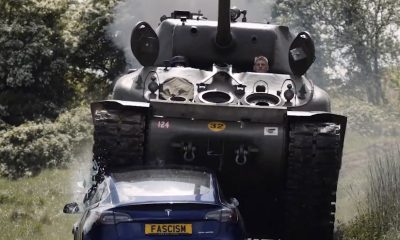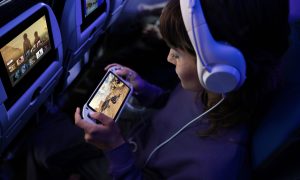

News
Here’s what SpaceX’s first Starlink satellite rideshare mission looks like [photo]
By way of customer Planet, SpaceX has published the first view of its inaugural Starlink satellite rideshare mission, revealing three mini fridge-sized Earth imaging satellites perched on a stack of dozens of Starlink spacecraft.
Scheduled to launch no earlier than (NET) 5:21 am (09:21 UTC) on June 13th, SpaceX’s eighth launch of Starlink v1.0 satellites (Starlink V1 L8) could usher in a revolutionary new way for smallsat operators to get their spacecraft in orbit. The company’s first Starlink rideshare customer has become a vocal supporter in the days before the first launch, praising unprecedentedly low launch costs SpaceX is able to offer. In fact, executives of Planet – now the world’s second most prolific satellite launcher after SpaceX – were so surprised at the prices the launch company was charging that they “could not believe what [they] were looking at”.
To account for the mass added by three Planet SkySats (~350 kg or 770 lb), SpaceX revealed earlier today that it had removed two Starlink satellites – each weighing ~260 kg (570 lb) – from the original stack of 60 spacecraft. Aside from confirming that Falcon 9 is balancing at the very edge of its performance envelope to launch ~16 metric tons (~35,000 lb) of satellites while still enabling booster recovery, the removal of two Starlink satellites to make way for rideshare payloads hints at an incredible level of flexibility available to SpaceX.

For customers of the fledgling small satellite rideshare program interested in procuring launch services directly, Planet’s SkySats are almost perfectly sized to extract the most bang for the buck from SpaceX’s current pricing system. Planet likely spent a bit more to have SpaceX build it a custom adapter and deployment mechanism for two launches, but the company’s launch costs for six SkySats – split between two June 2020 Starlink missions – could be as low as $6 million based on SpaceX’s own calculator. Due to the general secrecy of launch prices, it’s hard to accurately compare, but Planet would have had to pay upwards of $40 million – almost seven times as much – to launch six SkySats on dedicated Rocket Lab Electron rockets.

In return for $5-30+ million dollars in savings, Planet’s six new SkySats will have to work to raise their orbits from around 300 to 450 kilometers (190-280 mi) after deploying from SpaceX’s Starlink satellite stack. That work will expend a significant portion of their propellant reserves, likely cutting several months (up to several years) off of their operational lifespans. Believed to cost around $3-5 million each, however, the money Planet has saved by launching SkySats with SpaceX could potentially pay for an entirely new batch of six more satellites (or more).
With cost savings like that at hand, it’s no wonder that Planet’s Mike Safyan – Vice President of Launch – described SpaceX’s Starlink rideshare program as “incredibly competitive” and “one of the more significant programs for the smallsat industry”. Having overseen the launch of hundreds of Planet’s Dove and SkySat satellites over the last nine years, it would be hard to find a more qualified industry voice on the subject. Indeed, the rest of the smallsat industry is also responding positively to SpaceX’s new offering, with dozens of commercial spacecraft already assigned to future rideshare launches.

At this point, SpaceX plans to offer rideshare opportunities on Starlink missions every month for the indefinite future, all while charging as little as a $1 million per slot. Thanks to third-party launch services companies like Spaceflight and Exolaunch, much smaller cubesats and nanosats will also have ways to get into orbit on SpaceX rockets for much less than the company’s base price. Meanwhile, scheduled to launch no earlier than June 22nd, SpaceX’s very next Starlink launch – V1 L9 – is expected to include three more Planet SkySats and two similar BlackSky imaging satellites.
If SpaceX can maintain the impressive inertia of its Starlink launch and rideshare efforts, it’s safe to say that the company is going to be a towering presence in the smallsat launch industry for the foreseeable future.
Check out Teslarati’s Marketplace! We offer Tesla accessories, including for the Tesla Cybertruck and Tesla Model 3.
Elon Musk
USDOT Secretary visits Tesla Giga Texas, hints at national autonomous vehicle standards
The Transportation Secretary also toured the factory’s production lines and spoke with CEO Elon Musk.

United States Department of Transportation (USDOT) Secretary Sean Duffy recently visited Tesla’s Gigafactory Texas complex, where he toured the factory’s production lines and spoke with CEO Elon Musk. In a video posted following his Giga Texas visit, Duffy noted that he believes there should be a national standard for autonomous vehicles in the United States.
Duffy’s Giga Texas Visit
As could be seen in videos of his Giga Texas visit, the Transportation Secretary seemed to appreciate the work Tesla has been doing to put the United States in the forefront of innovation. “Tesla is one of the many companies helping our country reach new heights. USDOT will be right there all the way to make sure Americans stay safe,” Duffy wrote in a post on X.
He also praised Tesla for its autonomous vehicle program, highlighting that “We need American companies to keep innovating so we can outcompete the rest of the world.”
National Standard
While speaking with Tesla CEO Elon Musk, the Transportation Secretary stated that other autonomous ride-hailing companies have been lobbying for a national standard for self-driving cars. Musk shared the sentiment, stating that “It’d be wonderful for the United States to have a national set of rules for autonomous driving as opposed to 50 independent sets of rules on a state-by-state rules basis.”
Duffy agreed with the CEO’s point, stating that, “You can’t have 50 different rules for 50 different states. You need one standard.” He also noted that the Transportation Department has asked autonomous vehicle companies to submit data. By doing so, the USDOT could develop a standard for the entire United States, allowing self-driving cars to operate in a manner that is natural and safe.
News
Tesla posts Optimus’ most impressive video demonstration yet
The humanoid robot was able to complete all the tasks through a single neural network.

When Elon Musk spoke with CNBC’s David Faber in an interview at Giga Texas, he reiterated the idea that Optimus will be one of Tesla’s biggest products. Seemingly to highlight the CEO’s point, the official Tesla Optimus account on social media platform X shared what could very well be the most impressive demonstration of the humanoid robot’s capabilities to date.
Optimus’ Newest Demonstration
In its recent video demonstration, the Tesla Optimus team featured the humanoid robot performing a variety of tasks. These include household chores such as throwing the trash, using a broom and a vacuum cleaner, tearing a paper towel, stirring a pot of food, opening a cabinet, and closing a curtain, among others. The video also featured Optimus picking up a Model X fore link and placing it on a dolly.
What was most notable in the Tesla Optimus team’s demonstration was the fact that the humanoid robot was able to complete all the tasks through a single neural network. The robot’s actions were also learned directly from Optimus being fed data from first-person videos of humans performing similar tasks. This system should pave the way for Optimus to learn and refine new skills quickly and reliably.
Tesla VP for Optimus Shares Insight
In a follow-up post on X, Tesla Vice President of Optimus (Tesla Bot) Milan Kovac stated that one of the team’s goals is to have Optimus learn straight from internet videos of humans performing tasks, including footage captured in third person or by random cameras.
“We recently had a significant breakthrough along that journey, and can now transfer a big chunk of the learning directly from human videos to the bots (1st person views for now). This allows us to bootstrap new tasks much faster compared to teleoperated bot data alone (heavier operationally).
“Many new skills are emerging through this process, are called for via natural language (voice/text), and are run by a single neural network on the bot (multi-tasking). Next: expand to 3rd person video transfer (aka random internet), and push reliability via self-play (RL) in the real-, and/or synthetic- (sim / world models) world,” Kovac wrote in his post on X.
News
Starship Flight 9 nears as SpaceX’s Starbase becomes a Texan City
SpaceX’s launch site is officially incorporated as Starbase, TX. Starship Flight 9 could launch on May 27, 2025.

SpaceX’s Starbase is officially incorporated as a city in Texas, aligning with preparations for Starship Flight 9. The newly formed city in Cameron County serves as the heart of SpaceX’s Starship program.
Starbase City spans 1.5 square miles, encompassing SpaceX’s launch facility and company-owned land. A near-unanimous vote by residents, who were mostly SpaceX employees, led to its incorporation. SpaceX’s Vice President of Test and Launch, Bobby Peden, was elected mayor of Starbase. The new Texas city also has two SpaceX employees as commissioners. All Starbase officials will serve two-year terms unless extended to four by voters.
As the new city takes shape, SpaceX is preparing for the Starship Flight 9 launch, which is tentatively scheduled for May 27, 2025, at 6:30 PM CDT from Starbase, Texas.
SpaceX secured Federal Aviation Administration (FAA) approval for up to 25 annual Starship and Super Heavy launches from the site. However, the FAA emphasized that “there are other licensing requirements still to be completed,” including policy, safety, and environmental reviews.
On May 15, the FAA noted SpaceX updated its launch license for Flight 9, but added: “SpaceX may not launch until the FAA either closes the Starship Flight 8 mishap investigation or makes a return to flight determination. The FAA is reviewing the mishap report SpaceX submitted on May 14.”
Proposed Texas legislation could empower Starbase officials to close local highways and restrict Boca Chica Beach access during launches. Cameron County Judge Eddie Trevino, Jr., opposes the Texas legislation, insisting beach access remain under county control. This tension highlights the balance between SpaceX’s ambitions and local interests.
Starbase’s incorporation strengthens SpaceX’s operational base as it gears up for Starship Flight 9, a critical step in its mission to revolutionize space travel. With growing infrastructure and regulatory hurdles in focus, Starbase is poised to become a cornerstone of SpaceX’s vision, blending community development with cutting-edge aerospace innovation.
-

 News2 weeks ago
News2 weeks agoTesla Cybertruck Range Extender gets canceled
-

 Elon Musk6 days ago
Elon Musk6 days agoTesla seems to have fixed one of Full Self-Driving’s most annoying features
-

 Lifestyle2 weeks ago
Lifestyle2 weeks agoAnti-Elon Musk group crushes Tesla Model 3 with Sherman tank–with unexpected results
-

 News2 weeks ago
News2 weeks agoStarlink to launch on United Airlines planes by May 15
-

 News2 weeks ago
News2 weeks agoTesla Semi gets new adoptee in latest sighting
-

 News2 weeks ago
News2 weeks agoTesla launches its most inexpensive trim of new Model Y
-

 News2 weeks ago
News2 weeks agoUS’ base Tesla Model Y has an edge vs Shanghai and Berlin’s entry-level Model Ys
-

 News2 weeks ago
News2 weeks agoTesla Cybertruck owners get amazing year-long freebie




















